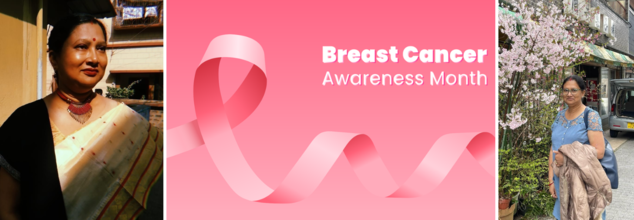- Health Conditions A-Z
- Health & Wellness
- Nutrition
- Fitness
- Health News
- Ayurveda
- Videos
- Medicine A-Z
- Parenting
- Web Stories
I Survived: 'Women Are Not Taught To Touch Themselves...How Will They Know If They Have Breast Cancer?'

Every year in October, we observe breast cancer awareness month and for the longest, to me, it was just an important health month to spread awareness about it. However, things changed for me, and it changed twice.
"It Is Just A Lump"
The first time my life changed was back in June 2018, when my mother, a resident of Delhi, Dilshad Garden to be specific, 48 years old, discovered a lump in the left side of her chest. This is when I was just about to start my bachelor's from the University of Delhi. As excited as I was to live the university life, there was a lingering anxiety.
My mother, while resting one day, felt something on her chest. She tried to feel it, but could not. No one teaches women to touch themselves. It is still a taboo, and remains so when campaigns around breast cancers call breasts everything else, but what it really is - breasts!
This was also when my father was not in town, she called him and shared what she just found in her chest. He suggested to go see a gynaecologist. My mother went to someone she trusted, a gynaecologist, even I know of. The doctor asked her to get a breast X-ray, however, it had no clear results.
After a medical examination, the doctor asked her to get a mammography done and suggested that she see a different doctor, but did not tell her who to consult. My mother was confused, "I did not even know it could be something serious, I thought it's just a lump," she said as she narrated the story to me.
"I went to Savita Vihar because there was no imaging lab that had mammography services around our house," my mother told me. However, the mammography results were also not clear. "It was clear that lump existed, but no one was ready to tell me if it was cancerous. Then I was suggested to get a fine needle aspiration (FNA) done," she explained.
As fancy as it sounds, the procedure is not so fancy. FNA is done using a thin needle and syringe to extract fluid from a suspicious area of the body and is then diagnosed to rule out any cancerous condition. "We got this done in Preet Vihar because that was the only nearby place where FNA was performed. When we got the reports, it had numbers, but no one told us what it was. The guy who handed the reports came out with a long sad face. Even though we did not know if it was cancer, his expressions were enough of a hint," she said.
With the reports, my mother and my father went to a family doctor, a general surgeon of a nursing home in Laxmi Nagar, which now remains closed. This was though far from our house; it was close to Preet Vihar, where she had gotten her FNA. The doctor suggested that she get her lump removed. "This is when your dad asked him if he should take me to a hospital to an oncologist because we were doubting if it was cancerous. But the doctor said there was no need and that it would take us ages to get one appointment with a doctor in big hospitals, so we just got it removed. We sent it for biopsy at two different imaging labs," she recalled.
The "C" Word
The reports came out from both the labs, and there it was. My mother had Stage 1 breast cancer, but was not told, till after her first surgery. She then finally went to Max Hospital in Vaishali and consulted an oncologist. "The doctor there said that I would be put on medications, but that would be enough, I was happy that there won't be any surgeries," she said.
However, life had other plans. Her new doctor also suggested that she get her lump sample transferred to Max Hospital from the previous imaging labs for another biopsy. "After the biopsy at Max Hospital, I was told that there were cells which could still be active around the area of my left breast where the lump was found. The doctor said that if we hadn't removed the lump, then they could've performed a comprehensive test around the area on my breast where the lump was detected to see whether cells were multiplying. If they were, they would have taken care of that in just one surgery. However, the only way to know now whether any cells are multiplying is through another surgery," she explained.
This was an axillary lymph node dissection (ALND), where a lymph node from her armpit was to be removed and sent for biopsy in the middle of surgery. If it came positive then the nodes would be removed from her armpit, if it came out negative, then the area would be stitched, with just one of the tested samples of lymph nodes removed.
While the tests were negative, which meant no cells were active, this surgery made her weak. She could not lift her left arm and had numbness around her left hand for more than one year.
Cancer Never Truly Goes Away
Even though she was cancer-free, she was now suggested radiation therapy. "It was a difficult time because it was painful and it felt like my body was burning. I smelled like burnt flesh. I would feel really hot even when the AC was on," she said.
She was then prescribed medicines that lowered her estrogen levels. These medicines were called "life-saving drugs" and were prescribed to her for 5 years. I remember getting these medicines every three months from a CGHS-designated medical dispensary, near RK Ashram Marg at subsidised rates because otherwise they were very costly.
The medicines lowered her estrogen levels because estrogen stimulates hormone receptor-positive breast cancers to grow, lowering the estrogen level can help slow the cancer's growth or help prevent it from coming back. However, this did not sit well with her menstrual cycle.
Due to low estrogen levels, her periods became irregular, however, it did not ring any bell because she was anyway nearing her menopausal age. Upon one of the regular checkups, it was found that her uterus which was supposed to be 3 inches long, 2 inches wide and 1 inch thick, grew 6 times its original size. "This happened because low levels of estrogen messed up my periods and instead of bleeding out, all the blood was collected inside my uterus. The doctor suggested that I get a uterus cleaning done every month, or get it removed. To me, removal sounded more feasible than to visit the hospital every month," she explained.
After my mother got her uterus removed, she bled uncontrollably and had to be operated again. This led to two abdominal operations on the same day, creating a lump or swelling near the site of the scar. This later led to a hernia, leading to another operation. Meanwhile, she was still on her medications, and it was slowly affecting her memory, she started to forget things.
Sometimes I would come back from college in the afternoon and she would open the door and go back to sleep and would forget in the evening that I was home. She would wake up in shock seeing me at home, asking when I came. It was a difficult time. I had never seen my mother like this. She was always smart and had the best memory. She was like our Google map before it was even a thing. Now she could not remember if her daughter was back home.
These medicines had other side effects too, like weak bones, lack of calcium, high blood pressure and other hormonal imbalances. Due to her hernia, her spermatic veins also swelled and caused varicose veins.
However, like any other phase, this too had to pass and it did. After 5 years of continuous pain, weaknesses, surgeries, and all of us trying to be there for her, in April 2023, after all her tests were done, she was finally off her "life-saving drugs". She will soon turn 55, and is living her life, travelling between India and Japan, with the three kids she loves the most, which includes not my sister and I, but a rabbit, and two Indies that our family adopted!
The Second Time My Life Changed
Hearing her narrate her story changed my life because, before today, I did not know that she was misled till she had her first surgery. I did not know that the stigma around breast cancer was so strong that not only did people not mention it, but medical professionals too did not guide her. Maybe there would have been one less surgery or maybe her hand wouldn't have gone numb for one whole year had she been guided and her diagnosis been done right.
Touch Yourself!
One thing she told my sister and me is what she learned from her radiologist at Max Hospital. "When she asked me how I got to know about the lump, I told her I just randomly noticed one day. She asked me, 'Randomly? Do you not check yourself?' I told her that nobody checks themselves, women are not taught to do it. How will they know they have breast cancer? There should be more awareness and people should come out to talk about it."
This is not a remote area where people are not aware. This is the capital city. Still, due to a lack of awareness, there was a delay and ambiguity that guided my mother's diagnosis of breast cancer. This is why, breast cancer awareness month for me, is the utmost important period to spread awareness.
To All The Women:
Her radiologist's advice was: If you are a menstruator, check your breasts and armpits for any lumps on every 3rd day of your period.
If you have hit your menopause, then select any date of a month and check your breasts on that date every month.
Your Sense Of Smell Could Decide How Long You Live, According To Doctor

Credits: Canva
Smell is a sense that helps us navigate, feel, and in fact remember things. Thanks or not, but Covid-19 also helped us know its importance, when many people lost the sense of their smell, as one of the major COVID-19 symptom. But, that is not just it, in a podcast posted on Instagram Dr Sanjay Bhojraj, board-certified interventional cardiologist talked to Dr Michael Leon, PhD Professor Emeritus of Neurobiology and Behavior at the Charlie Dunlop School of Biological Sciences on surprising link between smell and overall well-being.
Can Smell Predict How Long Will You Live?
“By the time you reach middle age, your sense of smell can actually predict all-cause mortality,” says Dr Leon. “That means whether you live or die, for any reason, can be accurately reflected in your ability to detect odors.”
The expert says that out olfactory system bears a direct impact to the brain's memory and emotional centers. “It has a great deal of impact when you lose it. And also when you amplify it. When you smell a pleasant odor, it activates the cerebellum and increases sniffing. For example, when you smell a rose, you naturally take a deep sniff.”
How Does Smell Impact Your Brain?
When you encounter a bad or disgusting odor, your body reflexively stops respiration. You instinctively avoid breathing it in,” Dr Leon says.
The expert said it is these subtle responses that influence one's memories, emotions, and overall brain function. “The olfactory system is just much more powerful than most people realize,” he says.
Can Body Odor Also Reveal Things About Your Health?
This link between smell and health became famous when Joy Milne, a retired Scottish nurse, claimed she could detect Parkinson’s disease by scent alone. Years before her husband’s diagnosis, she noticed a distinct musky odor on him. When she later met others with Parkinson’s, they all carried the same smell. Curious scientists put her to the test — and she correctly identified patients just by sniffing their shirts, even predicting one man’s diagnosis a year before doctors confirmed it.
Her unique ability led researchers like Professor Perdita Barran at the University of Manchester to discover that people with Parkinson’s excrete specific lipid-like molecules through their skin. These include hippuric acid and octadecanal, which may form the disease’s distinct odor. Barran’s team is now developing a simple skin-swab test that could help doctors detect Parkinson’s much earlier.
Different diseases create different odors. For example, a fruity or “rotten apple” smell can indicate uncontrolled diabetes, caused by a build-up of ketones. A fishy or ammonia-like scent might suggest kidney problems, while a musty smell could point to liver disease. Even infections leave olfactory traces — cholera, tuberculosis, and C. difficile each produce distinct, unpleasant aromas.
Is It Possible To Get The Same Cold Twice?

Credits: Canva
Did you also wake up with a mild cold? A sneeze, blocked nose and a sore throat. It is worse because you had just shaken off the miserable cold and your energy was finally coming back and then now again you are sneezing. So, now the question is, could you really get the same cold twice, or is it just your bad luck?
As per the National Health Service, UK (NHS), adults could get an average of 2 to 4 colds a year. The NHS, UK notes that the viruses behind them behave in a complicated way. This is because some mutate quickly, and some stay in your system. This is why your body's ability to fight them off can differ depending on how well does your immune respond.

Catching The Same Cold, Twice
Conventionally, it is believed that once you have a virus, your body recognizes it and does not let you catch the same virus again. However, this is not the case, always.
Professor Brain Ferguson, who is the professor of viral immunity at the University of Cambridge told Yahoo UK, that it is possible to catch cold twice. This is due to the levels of antibodies that we have in our system.
Ferguson says, "It depends on the quality of the antibodies that your body generates when you get infected the first time. Sometimes your body might make really good ones, and that will stop you being reinfected with the same virus later. But another person might not, and they can catch the same virus, exactly the same one, again later."
The expert further added, "It is also down to the actual molecules, and the constituents of the virus, like proteins and things you make antibodies against. The longer they exist in your body, the better the antibody response tends to be."
This means that the cold can stay in your system, and the longer it stays the better your immune system will be prepared to build up a stronger defense.
Reinfection Time: How Long Does It Take?
If you had two colds very close together, you may not have had enough time to build immune response the first time. Ferguson says, "Reinfection can be very fast."
"It can be as soon as a couple of weeks if the antibody response is very weak... You might pick up a virus and get a few minor symptoms, but fight it off really quickly. In that case, you get much weaker antibodies that fight the virus, which means the same virus appears in your system again very quickly."
This means your body only has a "fleeting encounter" with the virus and thus it won't remember it well enough to protect you the next time. However, a more severe cold may trigger a stronger immune response, which can work as a longer-lasting protection.
Why Some People Catch More Often?
This has something to do with genetics. This is because of their immune system, how good it works against different infections. As Ferguson says, "Some people are just naturally better or worse at fighting off viruses or bacteria due to their genetic makeup."
While it is believed that multivitamins and supplements can help "boost" immunity, Ferguson says that the evidence is mixed.
There’s not a great evidence base for [vitamins] for repeat infections," he says. However, Ferguson adds there is evidence that people who spend more time outside and get more vitamin D tend to have a slightly better-functioning immune system.
Harvard Physician Sue Goldie Finally Reveals After 4 Years About Her Parkinson's Disease

Credits: Harvard TH Chan
"I wouldn't use the word hide," said Dr Sue Goldie to NPR, she is a professor at the Harvard TH Chan School of Public Health, who has finally told the world after four years about her Parkinson's.
She learned about her diagnosis in 2021. She told NPR, "I think I was really trying to give myself room and time to fall apart, to panic, to think about what it meant for me.” For Goldie, silence wasn’t secrecy, it was self-preservation.
She revealed she needed space to understand to first accept that it is happening with her, and secondly to understand how to live with a condition that would alter her movements, her voice, and even her sensing. So she calls the 4-year-gap of not telling anyone as a "process of figuring out how I could be OK."
Parkinson's Disease: How Does It Start?
We often read about Parkinson's disease, what is it, and what it does to someone. However, what we do not talk a lot about is how it starts. We don't talk about the subtle signals one's body sends.
Goldie says it started with a tremor. It was so slight, that it was almost invisible. Then, a running coach mentioned her off cadence. The New York Times (NYT) reports that a trainer noticed her left arm did not lift properly in the pool. Eventually, afterwards, her fingers began twitching. Goldie, then was 50.
She was also at the height of her academic career and was newly obsessed with triathlons. She was in fact, training for Ironman races, reported NYT.
When tests confirmed Parkinson’s, a degenerative neurological disease that affects movement and coordination, her first reaction was disbelief. Then fear. Would her students notice? Would colleagues see her differently?
The diagnosis left her confronting an identity crisis. At what point, she wondered, does a disease become who you are?
Sue With Parkinson's, Who Lived Two Lives
Goldie began to divide her world. At Harvard, she was the confident professor and global health leader, still producing intricate teaching materials and mentoring students. In triathlons, she was freer, surrounded by people who saw her as an athlete, not a patient.
But the effort to maintain that balance came at a cost. As reported by NYT, early mornings were the hardest: walking unsteadily to the bathroom before medication took effect, hiding tremors from colleagues, managing the dopamine pills that controlled her symptoms. “You have no idea how hard it is to trick you into thinking I’m OK,” she later said.
Eventually, she could no longer keep it private. “Starting today, I am Sue with Parkinson’s,” she decided. Most of the people in her professional life would learn about it through her story.
The Camera For Healing
When Goldie's hand tremors made writing impossible, she began to record thousands of video diaries. They were often short, unfiltered glimpses of her daily struggle, which were filmed in her office, car, or home. Sometimes, calm, sometimes in tears.
Her videos began with a "Hello Sue", talking to her future self. In one video as posted by the NYT from 2023, she confessed, “I’m trying hard to do all this stuff that will help, but I’m not feeling OK... I just need to not be alone with it.”
Goldie refused to stop training. Her research had shown that exercise helps manage Parkinson’s symptoms. So, she doubled down, calling herself “an N of 1” — a one-person experiment. She adapted creatively: pink tape on her hands to guide her swim strokes, modified gear on her bike so she wouldn’t lose balance.
In 2022, she completed the Lake Placid Ironman, a 140.6-mile challenge. She crossed the finish line after collapsing, crying, and reapplying lipstick. Her small team called her S.F.G., with the middle initial standing for an unprintable word that captured her spirit.
As her symptoms progressed, Goldie’s fears shifted from physical decline to the erosion of identity. Parkinson’s, she realized, isn’t just about tremors; it’s about dignity, perception, and the quiet grief of being misunderstood.
She worried about whispers at Harvard, about whether others would still see her as capable. When she finally told university leaders, she felt both vulnerable and relieved.
Still, her mission remained unchanged. “I can’t change this,” she told The New York Times in 2024. “So what happens when I get worse?”
She continued teaching, designing, and mentoring. Her hands might tremble, but her mind stayed sharp. “I want to get things done while I’m still the best me,” she said.
© 2024 Bennett, Coleman & Company Limited

